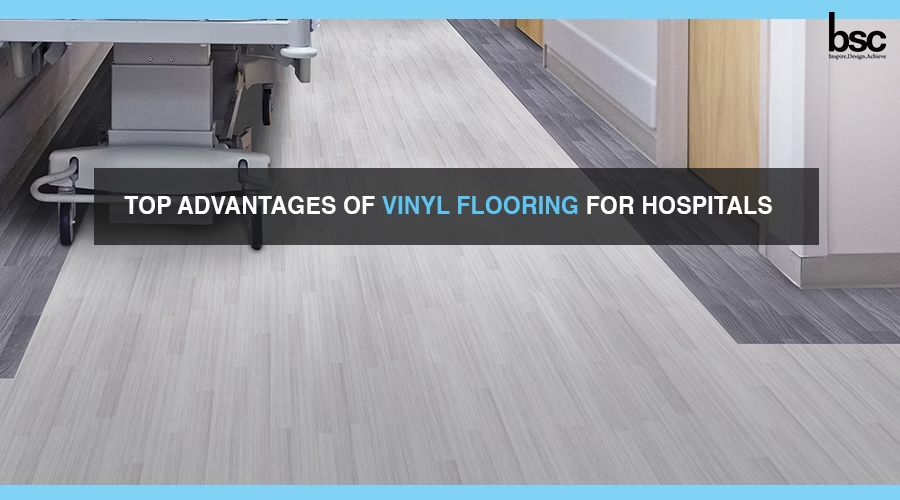Table of Contents
Overview: Advantages of Vinyl Flooring
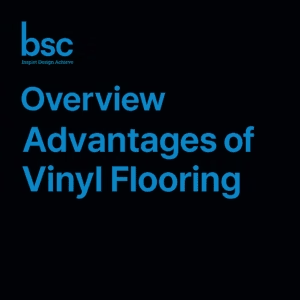
Hospitals require comfort, hygiene, and durability to work in the same area. Any healthcare franchise, be it an emergency room, patient room, etc., needs flooring that can withstand the weight of constant traffic, prevent slips and falls, and yet not be congested.
Unlike traditional materials, vinyl flooring offers flexibility, hygiene, and affordability in a single solution, which has become a priority for use in modern healthcare areas. Its waterproof capabilities, antimicrobial properties, cleanability, and multi-purpose usage make vinyl flooring a solution that saves hospitals the time spent in constantly repairing their floors and enables them to focus more on patient care.
In this comprehensive guide, we will share the most significant advantages of vinyl flooring in hospitals, including durability, antibacterial effects, acoustics, noise absorption, etc., and how it has emerged as one of the most trusted hospital flooring options in the hospital design field.
Introduction: Why Flooring Matters in Hospitals
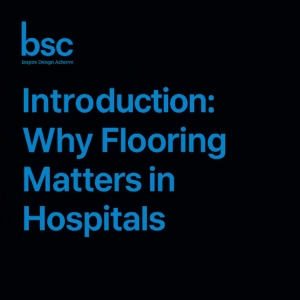
Most of us consider state-of-the-art medical equipment, spacious wards, and other modern lighting equipment when thinking of hospital design or renovation. Given that the floor is not just a surface on which a person or staff can walk, there are specific challenges that can be improved in terms of patient safety, hygiene control, and staff efficiency levels.
Hospital floors have to face some of the most unpleasant environments:
- Constant movement of people: Doctors, nurses, patients, and visitors walk thousands of steps every day.
- Heavy equipment traffic: From stretchers and wheelchairs to giant diagnostic machines, hospital floors have to withstand constant rumbling traffic.
- Strict cleaning routines: Floors are regularly treated with hospital-standard disinfectants and must be able to withstand periodic wet cleaning without compromise.
- Exposure to spills: Blood, medicines, food, and chemical solutions are likely to fall on the floor, and it must be well equipped with stain-resistant surfaces that can be easily cleaned.
Due to these factors, hospital flooring must be durable, safe, hygienic, and low-maintenance. Budget-grade flooring can lead to floor cracks, bacteria growth, slippage, or even expensive renovation costs – all of which impact patient care. Among the many options that meet these requirements, vinyl flooring has been proven to not only meet current standards but also exceed them, making it a top choice in all modern medical institutions across the global community.
What is Vinyl Flooring?
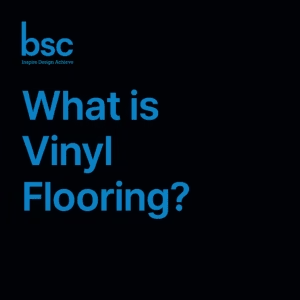
Vinyl flooring is a new, versatile, eco-friendly flooring option that is primarily made of polyvinyl chloride (PVC) and other additives that give it flexibility, strength, and style.
Compared to traditional building materials like wood or stone, vinyl is affordable, durable, versatile, and at the same time, doesn’t compromise on its aesthetics.This will help hospitals ensure a friendly and professional atmosphere without the hassles of natural flooring.
Key Features of Vinyl Flooring:
- Moisture resistance: Unlike wood, vinyl does not absorb water, so it is best suited for places where water must be avoided, such as ICUs, operating theatres, and laboratories.
- Design flexibility: Vinyl is available in sheets, tiles, and planks, allowing it to be customized as per the interior Design, zoning, and colour coding adopted by the hospital.
- Resilient surface: Its anti-fatigue surface makes it more comfortable to stand on.
Top 17 Advantages of Vinyl Flooring For Hospitals
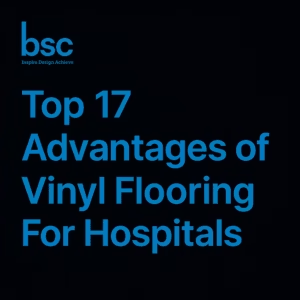
Here is the breakdown of all the advantages of vinyl flooring for hospitals:
- Easy installation
- Durability
- Water resistance
- Low maintenance
- Affordable
- Comfort underfoot
- Easy to clean
- Versatile
- Appearance
- Design flexibility
- Soundproofing
- Spill-resistant
- Environmentally friendly
- Kid and pet friendly
- Moisture resistance
- Scratch resistant
Easy Installation
Vinyl flooring is quick to install, whether it’s on a roll sheet, peel-and-stick tiles, or click-lock planks. This saves time and inconvenience in busy environments like hospitals or offices.
Durability
It can handle heavy traffic, wobbling equipment, or rolling vehicles without a dent because of the multiple layers of protection that keep it from getting damaged.
Water Resistance
Vinyl is naturally waterproof, so it can be used in bathrooms, kitchens, or even healthcare facilities where dirt is regularly accumulated and cleaning is required.
Low Maintenance
Vinyl is easier to clean or dust than wood or carpet. Apart from a good mopping from time to time, regular dusting is the only maintenance you need.
Affordable
Vinyl resembles high-quality flooring products like wood or stone, but at a significantly lower price, making it affordable.
Comfort Underfoot
The slightly cushiony nature of the vinyl material means it is more comfortable to walk and stand on than tiles and stone.
Easy to Clean
Vinyl is easy to clean; dusting or simple wipes can remove dirt and grime, leaving the interior looking clean and attractive.
Versatile
Vinyl is available in planks, tiles, and sheets and can suit any interior needs, whether it is home and hospital flooring, school flooring, office, or any other.
Appearance
With modern vinyl, the intricacy of wood, stone, or ceramic is replicated in a practical and robust way to enhance interiors.
Design Flexibility
Vinyl is available in countless colors, patterns, and textures, and can fit any theme – whether it is quiet hospital rooms or trendy office lobbies.
Soundproofing
Vinyl absorbs sound better than tiles or stone, and it helps to create a calm and relaxing atmosphere, especially in hospitals or apartments.
Spill-Resistant
Vinyl resists stains (unless you accidentally spill something black) and damage from accidents, while many resilient flooring options resist damage from accidents, such as in children’s kitchens or healthcare centers.
Environmentally Friendly
Most contemporary vinyl is made from low-VOC materials and recyclable materials that improve indoor air circulation and enhance its quality and durability.
Kid and Pet Friendly
Vinyl is scratch-resistant, stain-resistant, and soft on feet, so it’s safe and practical in homes with kids or pets.
Moisture Resistance
Unlike wood flooring or laminate flooring, vinyl doesn’t swell, warp, or grow mold in wet areas.
Scratch Resistant
The wear-resistant layer protects the floor from scratches from furniture, wheelchairs, or pet claws, keeping the floor in like-new condition.
Top Disadvantages of Vinyl Flooring For Hospitals
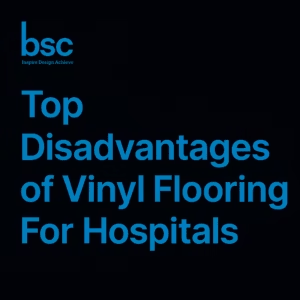
Here is the breakdown of the disadvantages of vinyl flooring:
- Scratches and Dents
- Difficult Removal
- Subfloor Requirements
- Environmental Concerns
- Resistance to Fading
- Water Damage
- Can Emit Volatile
- Organic Compounds (VOCs)
- Difficulty in Repair
- Durability Concerns
- Installation Cost
Scratches and Dents
Although vinyl is durable, it can be scratched by complex objects or dented by the weight of heavy items or furniture.
Difficult Removal
Vinyl flooring is easy to remove once it’s been applied; this type of flooring takes some time and effort to remove, especially over large areas.
Subfloor Requirements
Vinyl needs a smooth, even surface underneath to be correctly applied.
Environmental Concerns
Vinyl is produced from PVC, a non-biodegradable material. It’s not the most environmentally friendly flooring, but recyclable alternatives are available.
Resistance to Fading
Prolonged exposure to direct sunlight can cause vinyl to discolor, meaning it’s not suitable for sunny rooms without UV protection.
Water Damage
Since vinyl is waterproof, standing water seeping into a seam or edge can damage adhesion or the Subfloor over time.
Can Emit Volatile Organic Compounds (VOCs)
Some inexpensive vinyl floors may contain VOCs when new and may also impact indoor air quality if there is not adequate ventilation.
Difficulty in Repair
Unlike wood or tile, vinyl cannot be refinished, which means that damaged vinyl areas, especially sheet vinyl, usually have to be replaced entirely.
Durability Concerns
Lower-priced vinyl may be more susceptible to wear than higher-quality vinyl, especially in areas with high foot traffic.
Installation Cost
While the cost of materials is low, professional installation (especially in the case of sheet vinyl) can increase the overall expense.
Pros and Cons of Vinyl Flooring vs. Laminate Flooring
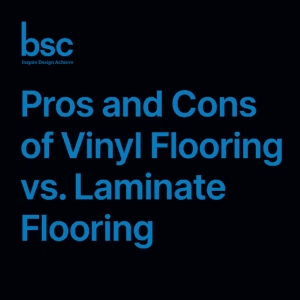
Here is the breakdown of the pros and cons of vinyl flooring vs. laminate flooring in the form of a concise table:
| Factor | Vinyl Flooring | Laminate Flooring |
| Water Resistance | 100% waterproof, it is ideal for use in hospitals, kitchens, and bathrooms. Without any damage, it can handle spills and repeated cleaning, including stagnant water. | Protect against moisture—may swell, warp, or bubble if exposed to water (spills). Do not use in wet areas. |
| Durability | Constructed using layers of protective materials. It resists scratches, impacts, and heavy traffic. Can withstand hospital equipment, stretchers, and wheelchairs. | Durable but more prone to cracking, scratching, and damage with light use and heavy objects. Ideal for dry, residential environments. |
| Maintenance | Low maintenance required. No more than periodic sweeping and mopping. Easy to disinfect, presenting an ideal solution in hygiene-sensitive environments. | Requires careful cleaning—cannot be wiped with a wet mop and requires special isopropanol to clean, and care must be taken to avoid exposure to moisture. |
| Comfort | Slightly spongy, extra soft, and puts less strain on feet for standing all day. Reduces fatigue for staff and patients in hospitals. | Solid surface with minimal (or no) cushioning. It can be tiring to walk on or walk on for long periods of time. |
| Cost | Economical with various price levels – Economy, Premium (LVT/LVP). | However, repairs and maintenance are necessary, which increases costs over time. |
| Appearance & Design | It can be replicated in any colour, texture, and look of wood/stone. Enhances interiors without being impractical. | Resembles wood, but has limited design variety compared to vinyl. |
| Best For | High traffic, moisture, and hygiene-sensitive areas such as kitchens, bathrooms, hospitals, and basements. | Dry, simple spaces like bedrooms, living rooms, and offices where form is a priority over waterproofness. |
Types of Vinyl Flooring
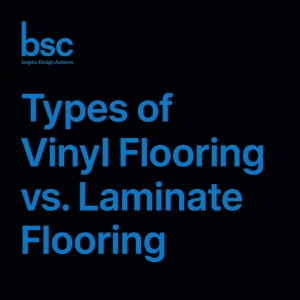
Here is a proper breakdown of all types of vinyl flooring:
Vinyl Plank Flooring (LVP)
Vinyl planks are designed to resemble and feel like genuine hardwood. They are available in click-lock or glue producer and thus are versatile and durable. In medical facilities, vinyl planks can be found in the waiting area, resuscitation rooms, or patient rooms where a cozy and attractive wood-like appearance is preferable and not at the expense of durability.
Vinyl Sheet Flooring
It is one of the most preferred tiles in hospitals. It is large in size and rolled, and can be applied to large areas without any obstruction. Since there are very few seams sticking to the body, it is very hygienic, waterproof, stain-resistant, and can be easily washed. It is also used in ICUs, operating theatres, laboratories, and corridors where hygiene is a must.
Peel-and-Stick Vinyl Flooring
These are self-adhesive tiles or planks and take very little time to install. Being economical, they have a shorter life span than commercial vinyl. In hospitals, these should be used only in temporary installations, shops, or places where there is less movement.
Luxury Vinyl Tile (LVT)
LVT is a high-end version of vinyl flooring and closely resembles stone or ceramic tiles. It has a thicker layer, which makes it more durable and comfortable underfoot. LVT is most common in hospital lobby areas, diagnostic or treatment centres, and VIP patient suites where design and patient comfort are equally valued.
Homogeneous Vinyl Flooring
It is made from a single solid layer of vinyl, making it extremely strong, durable, and easy to clean. It is resistant to stains and scratches and also resists direct exposure to chemical vapours, making it an ideal choice for hospitals where certain areas are sensitive, such as laboratories, operating theatres, and intensive care units.
Heterogeneous Vinyl Flooring
However, unlike uniform, it is multi-layered; a wearable layer is on top, and a printed design layer is underneath. It also offers a wide range of colours, patterns, and textures, so it is an attractive and practical option. It is installed in general wards, staff lounges, or waiting rooms of hospitals, as a balance of aesthetics and functionality is required.
Vinyl Composition Tile (VCT)
VCT is a combination of vinyl resin and fillers such as tires and limestone. It is strong and compact and can hold up well with little or no maintenance other than polishing and waxing. Many hospitals still use VCT in corridors and storage rooms, but not as much as before, as sheet vinyl or homogeneous vinyl are becoming more popular due to the lower maintenance required.
Loose-Lay Vinyl Flooring
This version is thicker and stays in place due to a backing material that holds it in place without the use of a friction grip or glue. It can be installed and removed temporarily, if someone needs to move temporarily (medical, rental space), or in the case of modular healthcare solutions that require flexibility.
Installation Process of Vinyl Flooring in Hospitals
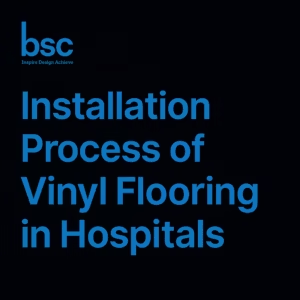
Installing vinyl flooring in hospitals is not just a matter of using some sheets or planks; it is a well-thought-out process that does not interfere with the hospital operations in terms of health, durability, and best hygiene.
- Surface Preparation: Hospitals require a hundred percent smooth and clean surface. Cracks and imperfections can hamper the hygiene conditions and create weak areas. Self-leveling compounds are usually used to get the right base.
- Moisture Testing: Hospitals often have wet cleaning as well; therefore, it will be essential to measure the moisture level of the sub-floor to prevent the possibility of mold and sticking.
- Installation Method:
- Sheet Vinyl: Vinyl is heat-welded to a seamless, waterproof surface – this prevents bacteria from accumulating in the joints.
- Luxury Vinyl Tiles (LVT) or Planks: These can be laid in waiting areas, corridors, or places where aesthetics are an essential factor. Generally, glue-down methods are popular in hospitals to increase stability.
- Minimal Downtime: Hospitals don’t have time to shut down large areas. Vinyl flooring can be laid in a short time, even overnight, so it doesn’t take long before work can resume.
- Sealing and Finishing: This involves applying a protective coating after installation that increases scratch resistance and slip resistance, and makes the cleaning process easier.
The proper installation process makes the flooring not only look aesthetically pleasing but also promotes infection control, safety, and durability in challenging hospital conditions.
We are providing best tarkett vinyl flooring solutions for hospitals you can check detailed guider from here.
Vinyl Flooring in Patient Rooms vs. Operating Theatres
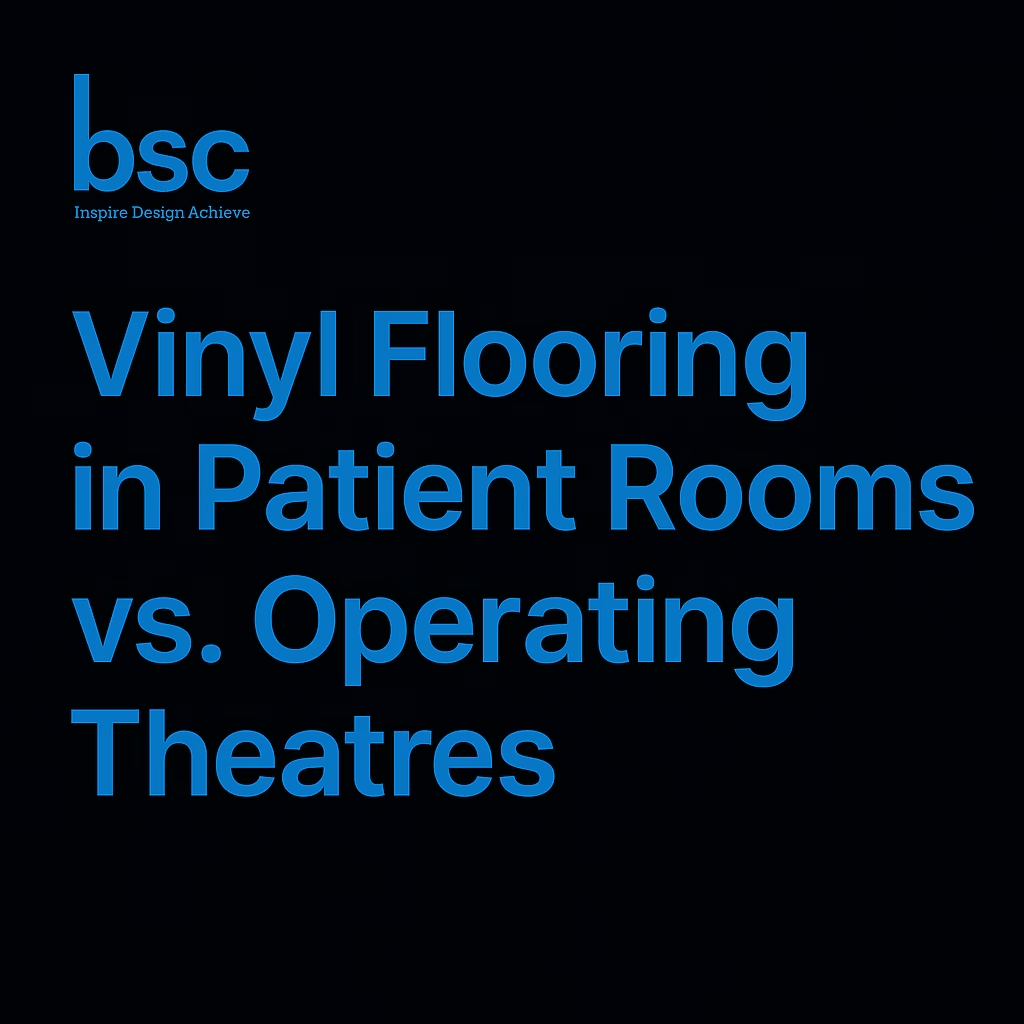
Hospital spaces are pretty unique, and vinyl flooring is flexible enough to conform to them.
- Patient Rooms:
- Focus: Comfort, beauty, and cleanliness.
- Vinyl was chosen for its warmth (wood or stone-like texture) and soft feel underfoot, which is comfortable for patients and staff who stand for long periods of time.
- Good cleaning capabilities are essential, as these rooms are washed several times a day.
- Operation Theatres (OTs):
- Focus: Sterility, hygiene, and anti-slip.
- Smooth, uniform sheet vinyl is favourable because its joints can be welded to form a continuous antibacterial surface.
- Floors in TOTs must be able to withstand the heavy use of disinfectants, spillage of body fluids, and movement of heavy equipment.
- Anti-static and antibacterial vinyl is used every day to eliminate contamination or spark hazards on medical equipment.
In simple terms, patient rooms will exude comfort and beauty, while operating theatres will be highly hygienic and sterile and able to withstand force.
How Long Does Vinyl Flooring Last in Hospitals?
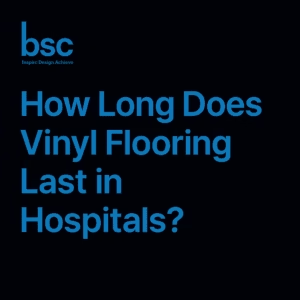
Vinyl flooring used in hospitals has a certain lifespan, which depends on several factors, including quality, installation, and maintenance. However, quality vinyl flooring used in hospitals lasts for 15 to 20 years.
- Wear Layer Thickness: This vinyl has a thick layer (0.5-1 mm), and its flooring can withstand wheelchairs, rolling beds, stretchers, and heavy foot traffic.
- Maintenance Influence: Vinyl looks the same for several decades with proper cleaning and care. However, neglect can reduce its lifespan.
- Area of Use: People movement in corridors and operating theaters is faster than in rooms with less movement.
- Replacement Cycles: Other hospitals renew vinyl flooring every 10-12 years to improve aesthetics or improve hygiene, although it is still in a usable condition.
With professional installation and regular maintenance, vinyl has one of the best ROI lifespans among the flooring options available in a hospital.
Common Mistakes to Avoid When Choosing Vinyl Flooring
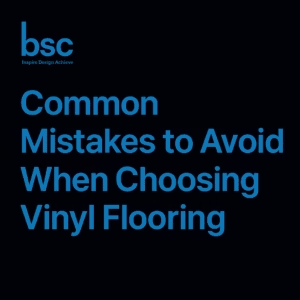
Vinyl is reasonably cost-effective, and hospitals don’t always get the most out of it:
- Ignoring Subfloor Preparation: Laying vinyl on an uneven, wet surface can result in bubbles, cracks, and mold.
- Choosing the Wrong Type: Installing vinyl planks in, say, an operating room when it should have seamless vinyl sheets instead is a hygiene issue.
- Overlooking Slip Resistance: In areas where there is a moist environment, such as bathrooms or laboratories, slippery vinyl should be avoided at all costs by means of anti-slip vinyl.
- Going for Cheap Products: Poor vinyl will not last long due to wear, fade in light, and may emit excessive VOCs.
- Poor Installation: Cracks due to improper welding of joints or weak adhesive can cause bacterial growth.
- Not Considering Maintenance: Many times, hospitals do not check the maintenance before choosing vinyl, which leads to the vinyl deteriorating quickly.
These mistakes must be avoided as they waste a lot of investment made in hospital flooring, as they reduce the performance, safety, and life.
ROI (Return on Investment) of Vinyl Flooring in Hospitals
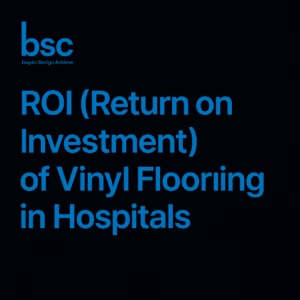
Hospitals can’t afford to make a wrong investment, so the ROI of vinyl flooring will be significant due to the balance between cost and performance.
- Low Installation Cost: Vinyl costs much less than tiles, stone, and wood.
- Reduced Maintenance Expenses: Vinyl is easy to clean and reduces the consumption of human labour and chemicals.
- Durability: It has high durability and can have a lifespan of up to 20 years, which limits its replacement cost.
- Energy Savings: Vinyl has a slightly cushioned and insulating surface, so hospitals don’t require much heating and cooling.
- Staff Productivity: Nurses and doctors can stand for more extended periods of time on a floor that is comfortable underfoot.
- Patient Satisfaction: Aesthetic, quiet, and clean environment improves health outcomes.
The cost benefits inherent in vinyl flooring really add up over time, and there is no doubt that vinyl flooring can be worth its value many times over.
Eco-Friendly Vinyl Flooring Options for Green Hospitals
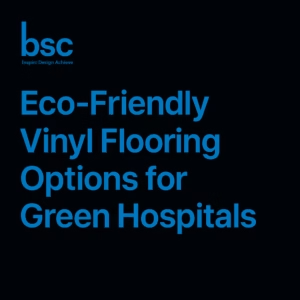
Contemporary hospitals are becoming more eco-friendly in terms of infrastructure, and vinyl flooring has advanced to keep up with these changes:
- Low-VOC Vinyl: This may be less harmful to indoor air quality, as it produces fewer toxic chemicals.
- Recyclable Materials: Some vinyl floors are made with recycled content and can be recycled again at the end of life.
- Bio-Based Vinyl: Bio-based vinyl is a newer product that is made using renewable raw materials instead of petroleum-based PVC.
- Energy-Efficient Production: It is a common trend nowadays for factories to use clean production systems that generate low-carbon energy.
- Certifications: Vinyl flooring must be certified eco-friendly and adhere to specific standards such as FloorScore or Greenguard.
Sustainable vinyl can enable hospitals to achieve green initiatives and keep their flooring clean and high-performing.
Vinyl Flooring for Specialized Hospital Areas
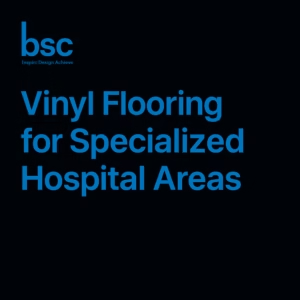
Hospitals are not uniform; concrete floors are needed in one area or another.
- Emergency Rooms: High-traffic areas, spills, and rolling equipment. Durable, slip-resistant vinyl is a must.
- ICUs: Sound-absorbing and hygienic flooring is needed to ease the load of sick patients.
- Labs: Must be resistant to chemicals, stains, and frequent cleaning. Special chemical-resistant vinyl is used.
- Maternity Wards: Thicker vinyl and padded backing are beneficial here, as both sound absorption and hygiene are essential.
- Pediatrics: Pediatric vinyl print colours help make the environment welcoming for children and avoid scaring them.
- Cafeterias & Kitchens: Cafeteria floors are non-slip vinyl floors that are slip-resistant to prevent falls and maintain safety and cleanliness.
- Waiting Areas: A sleek and classy look is essential here, and wood-look vinyl is more comfortable and warmer on the feet.
Because of this ability to adapt vinyl flooring to each zoning area, hospitals manage to achieve optimal performance and safety in all departments.
How to Maintain and Clean Vinyl Flooring in Hospitals?
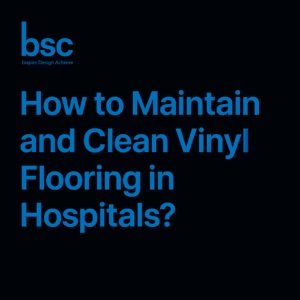
Vinyl flooring does not require much maintenance, although hospitals must follow special cleaning procedures:
- Daily Cleaning: It is advisable to avoid harsh chemicals that can damage the protective sealant.
- Spill Management: Mop up spills; do not allow them to dry: this will prevent staining and damage to adhesives.
- Polishing & Buffing: Polish frequently to maintain shine and strengthen wear.
- Deep Cleaning: Cleaning is done with an auto-scrubber to maintain optimum hygiene.
- Protective Measures: Apply floor protectors to heavy equipment and furniture before scratch and dent-related damage occurs.
- Routine Inspections: Inspect for gaps/separations, scratches, or dents that require immediate repair.
When properly maintained and cleaned, vinyl flooring in hospitals will always remain clean, hygienic, and durable – leading to increased patient safety and cost-effectiveness.
Maintenance & Cleaning of Vinyl Flooring in Hospitals
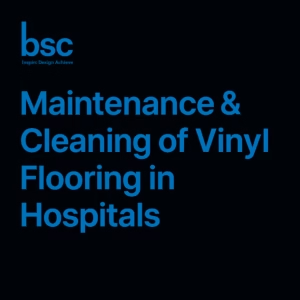
Vinyl flooring is perhaps the easiest flooring product to maintain in a hospital, and yet, the maintenance of floor surfaces in a healthcare facility presents a different context in terms of hygiene, infection control, and safety. Hospitals are 24-hour facilities, and every square foot of flooring must be clean, disinfected, and able to withstand daily cleaning.
Daily Cleaning Routines
- Dry Dusting or Sweeping: Hospitals have a lot of dust that is usually brought in by individuals such as patients and visitors. Regular sweeping reduces the chances of dust and other debris scratching surfaces.
Periodic Deep Cleaning
- Auto-Scrubbers: Auto scrubbers in hospitals refer to large floors where we see auto scrubbers with pad-type machine cleaners in places like lobbies, operating theatres, and even corridors.
Preventive Maintenance
- Furniture Protection: Ensure that chairs, beds, and appliances have furniture mats to protect them from scratches on the floor.
- Entrance Mats: Place some mats on doors as well to catch most of the stones and dust.
- Regular Inspections: Corners, welds, and joints should be inspected to ensure that no bacteria are accumulating.
Common Mistakes to Avoid in Maintenance
- Using strong acids or other abrasive cleaning compounds can destroy the wear layer.
- Leaving water or disinfectant pools sitting for too long can reduce adhesion.
- Ignoring minor scratches or dents that could harbor germs in the future.
Future of Vinyl Flooring in Healthcare
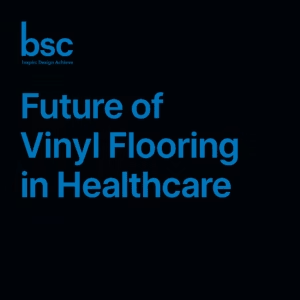
The healthcare industry is evolving rapidly, and so is vinyl flooring technology. New hospitals are being designed to be more efficient, environmentally friendly, and patient-focused, and flooring can directly contribute to these ideals.
Technological Advancements in Vinyl Flooring
- Antimicrobial-Infused Surfaces: New generation vinyl flooring has built-in antimicrobial properties that continuously prevent the development of bio-toxins.
Sustainability & Green Healthcare
- Recyclable & Bio-Based Vinyl: Recyclable and bio-based vinyl manufacturers are focusing on environmental sensitivity by using renewable or recycled materials as per green building requirements across the globe.
Patient-Centered Design
- Healing Environments: Future vinyl will have designs that strike a balance between beauty and health, such as natural textures, attractive designs, and sound-deadening capabilities that will aid in patient recovery.
Growth of Specialized Vinyl Flooring
- Static-Control Vinyl: Anti-static vinyl will be relevant in operating theatres, ICUs, and laboratories due to advancements in medical technologies.
BSC Interiors – Trusted Distributor of Tarkett Vinyl Flooring in India
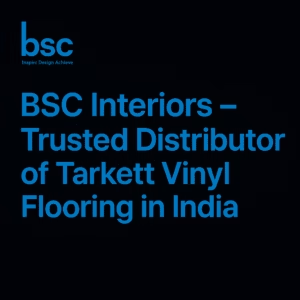 The flooring decision by hospitals is not just limited to choosing the right flooring material, but also about finding the right supplier who has a good understanding of the requirements of the healthcare industry. Here, BSC Interiors helps in deciding about the problem and determining how to solve it most effectively and efficiently, and in the most beneficial way for all concerned.
The flooring decision by hospitals is not just limited to choosing the right flooring material, but also about finding the right supplier who has a good understanding of the requirements of the healthcare industry. Here, BSC Interiors helps in deciding about the problem and determining how to solve it most effectively and efficiently, and in the most beneficial way for all concerned.
Partnership with Tarkett
As a proud distributor of Tarkett, one of the world’s most sustainable, healthcare-focused flooring companies, BSC Interiors has a wide selection of easy-to-clean vinyl flooring options at the most competitive prices. Tarkett vinyl flooring solutions are recognised as sustainable, hygienic, and eco-friendly solutions, making them the best flooring solution for hospitals around the world.
Why Choose BSC Interiors for Hospital Vinyl Flooring?
- Expertise in Commercial & Healthcare Projects: BSC Interiors has been supplying to hospitals, clinics, and healthcare centres, and understands the needs of healthcare environments well.
- Wide Product Range: Vinyl sheets and planks are versatile, yet at times, there are specific requirements in patient rooms, ICUs, operating theatres, and busy corridors.
- Eco-Friendly Options: As sustainability is being emphasized, BSC Interiors is offering Tarkett, which is a low-VOC and recyclable vinyl flooring that can help hospitals conform to green building standards.
- Technical Support & Installation Guidance: Along with the supply, BSC Interiors will also provide professional assistance in installation, usage, and the right product selection to ensure the life of the product.
- Competitive Pricing & ROI: Hospitals can get competitive pricing and long-term return on investment when using Tarkett flooring, which can be achieved through BSC Interiors.
Value Delivered to Hospitals
Hospitals using BSC Interiors can enjoy all these benefits due to the association of these companies with Tarkett, the best manufacturer of vinyl floor coverings.
- Minimum maintenance and cost of living.
- Guaranteed global quality standards.
- Flooring that is comfortable for patients and efficient for staff.
For any new hospital or special healthcare refurbishment project, BSC Interiors ensures that Tarkett vinyl flooring solutions are delivered with professionalism, reliability, and unrivalled expertise.
If you want to know more information about the Tarkett Flooring Solutions brand, then you can check here
Conclusion
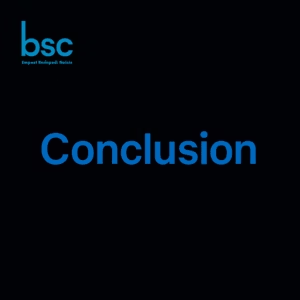 Vinyl flooring has become one of the most trusted and customized flooring solutions in hospitals. With its uniqueness in terms of hygiene, durability, safety, cost-efficiency, and modularity, this product is ideally suited for the healthcare sector.
Vinyl flooring has become one of the most trusted and customized flooring solutions in hospitals. With its uniqueness in terms of hygiene, durability, safety, cost-efficiency, and modularity, this product is ideally suited for the healthcare sector.
- It offers easy, quick, and sterile installation.
- In various departments of the hospital, it offers ease of modification and fitment in patient area rooms, sterility in operating rooms, and durability in emergency departments.
- Vinyl flooring, with proper maintenance, can last up to 20 years with hospital-level hygiene.
- It also has a good ROI that reduces the overall cost due to simple maintenance, durability, and patient satisfaction.
- Through sustainability and technologically advanced battery-powered vinyl flooring, hospitals can achieve their sustainability goals while also providing high-level patient care.
As it turns out, upgrading an outdated floor cleanup system is more than just a decorative decision: it’s an investment in patient safety, employee workflow efficiency, and long-term cost-effectiveness.
With advancements in the healthcare sector that have made healthcare facilities more intelligent and eco-friendly, vinyl flooring will continue to improve so that hospitals can be a clean, eco-friendly, and comfortable place to care for patients in the future and beyond.
